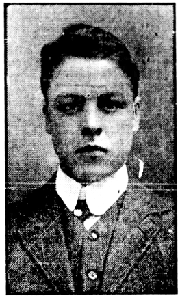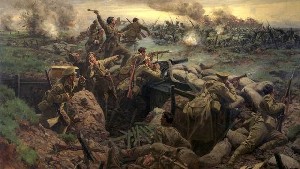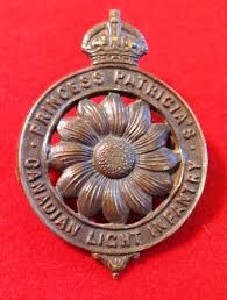
Thomas Bowlt

Painting by W.B. Wollen of the battle

PPCLI Cap Badge
Jean Longstaff has submitted the following:-
Born on 19th July 1892 in Seaham Thomas was the youngest son of Gateshead born Robert Bowlt and his wife Caroline. Robert had served with the Scots Guards in New Brunswick protecting the garrison during the US Civil War, and when the battalion returned to England he stayed and joined the US Army. He remained in New York after being discharged in 1867 and two years later married Caroline Kettenring. They returned with four children (John Henry, Robert, Hannah and Elizabeth) to live in Bill Quay in 1875, moving to live in South Shields the following year, where Mary Ann, Thomas, Caroline, Jacob and Margaret were born.
Moving to live in Green Street, Dawdon in 1885, their next four children all died in infancy, Stephen was born in 1890 followed by Thomas (also the name of a child who had died) and the youngest Ethel in 1894 after the family had moved to live in Derby Street, West Hartlepool, where Caroline died in 1902. A keen footballer Tom played for Burbank in the Hartlepool Juniors League. By 1911 father Robert, still working as a machinist, Thomas, a fireman at the steelworks, and Ethel who was working as a housemaid, were living with elder sister Elizabeth and her family also in Derby Street.
In 1912 Thomas arrived in Canada and made his way west to Saskatoon, Saskatchewan where he found work as a freight clerk for the Canadian National Railways, and also became a noted player for both the Christ Church and CNR football teams
Tom Bowlt mobilized with Princess Patricia’s Canadian Light Infantry on 12th August 12 1914 being one of the first to enlist for service in World War One. The PPCLI, although raised in Canada, did not see itself as a Canadian regiment and served until late 1915 as part of the British Expeditionary Force. Travelling to Lansdowne Park, Ottawa he enlisted two weeks later as Private 1639 of “D” Company, mentioning his time as a volunteer with the King’s Own Yorkshire Light Infantry before he left England.
The PPCLI sailed aboard the SS Royal George from Quebec arriving in Devonport on 18th October when the men were posted to Bustard Camp on Salisbury Plain. As part of the 1st Canadian Contingent they were inspected by King George V and Queen Mary, Lord Roberts and Lord Kitchener before moving to Winchester to join the 80th (Stonewall) Brigade, 27th Division BEF, where at the end of November Thomas was promoted to Lance Corporal.
20th December 1915 saw the PPCLI arrive in France on the SS Cardiganshire sailing from Southampton to Havre and becoming the first Canadian infantry battalion on the front line during WW1. Their first posting was to Blaringhem, Belgium where on 6th January they began their first front line trench tour east of Vierstraat, and shortly after Tom was promoted to Corporal with the Bombers Section, specialising in the making and throwing of grenades. Six weeks later they took part in the first Canadian trench raid of the war near Shelly Farm, St.Eloi.
Tom mentioned this raid in a letter home and it was published in British and Canadian newspapers, he wrote: “As we climbed over the parapet, the enemy, by means of magnesium flares, spotted us and immediately opened upon us with a most hellish and withering machine-gun fire. We lost men, but we kept on, plodding through a quagmire of mud, and when we jumped over the enemy’s parapet into their trench we had to tramp over dead men … In the captured trench we discovered plenty of food and clothing, and also some patent hand-warmers, which shows that they are well fed and fairly comfortable. Their trenches are made for comfort, and it makes them very careless about fighting positions.”
On 7th May 1915, the PPCLI was in front line trenches at Frezenberg, not far from Hooge, in a last ditch effort to stop a German offensive that had begun two weeks earlier. During the battle, Corporal Bowlt was either hit by shell splinters or by a bullet and one leg was blown off. The battle was so fierce that the wounded could not be evacuated for two days, when he was admitted to 13th General Hospital, Boulogne as “dangerously ill”.
Thomas Bowlt died on 14th May 1915 in Boulogne, after he had sent a letter home saying he was improving. He is buried at Boulogne Eastern Cemetery, where the soil is very sandy so all the headstones are laid flat on the ground.
De Ruvigny Roll of Honour states
Thomas Boult (sic) was born at Seaham Harbour, but moved to Canada from West Hartlepool in about 1910.
He volunteered on the outbreak of war and enlisted in the Princess Patricia's Canadian Light Infantry, he was severely wounded at Ypres, where he had a leg shot off, and died in the hospital at Boulogne.
Three of his brothers are on service, 2 in the Army and 1 in the Navy.
Thomas Bowlt is remembered at Hartlepool in H115.30 and West Hartlepool on W111.54
In Canada he is remembered on their Virtual War Memorial and in their Book of Remembrance, on the Saskatoon Footballers Memorial and in 2006 Bowlt Crescent in Saskatoon was named in his honour.
Canadian Book of Remembrance
Canadian Virtual Memorial
The CWGC entry for Corporal Bowlt

